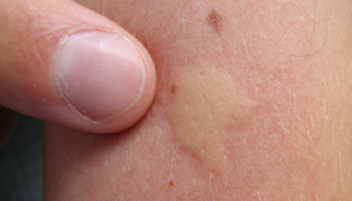
Insect Bites
Bug Bite Symptoms, Treatment and Prevention
Sometimes it seems that all the bugs in the world have nothing better to do than snack on humans.
Thankfully, most stings just cause a bit of pain and slight swelling; bites typically cause exasperating itchiness and unsightly welts. But some insects are extremely effective disease carriers, others can trigger a life-threatening reaction in someone who is allergic to their venom.
Symptoms
- Sting: Intense, burning pain quickly followed by redness and swelling is typical following a sting from a bee, wasp or hornet. The worst of the pain subsides in a few hours.
- Bite: Many (though not all) bites from insects like mosquitoes, flies, and gnats are painless at first, but a small, itchy, red irritated bump typically develops up to 24 hours after the bite and may last for several days.
Get medical help if:
Severe allergic reactions, when they occur, are far more common after insect stings (from a bee, wasp, yellow jacket, hornet, or fire ants) rather than insect bites, and require immediate medical attention. Symptoms of such a reaction may include:
- Overall itchiness experienced throughout the body
- A blotchy, and sometimes intensely itchy rash
- Flushed (red) skin or sudden paleness
- Swelling of the face, lips, tongue, throat, and upper airway.
- Stomach cramps and/or nausea
- Rapid heart rate
- Dizziness, fainting
- Wheezing or difficulty in breathing
Such reactions will usually develop within 10 minutes of a sting. While not all allergic reactions are severe, many can be life-threatening and all should therefore be treated as a medical emergency. Multiple stings from a swarm of venomous insects can also cause the symptoms listed above, due to high levels of venom rather than an allergic reaction. Seek immediate medical care if you are experiencing those symptoms.
Immediate Care
- If stung by a bee, remove the stinger and venom sack (the fuzzy bit protruding from the skin) promptly to reduce symptoms. Use a credit card, thumbnail or dull knife to scrape the stinger out from the skin without squeezing the venom sack.
- If bitten by a tick: Pull the tick from the skin, slowly and straight up, using tweezers or fingernails to grasp the tick as closely as possible to the skin. Try not to squeeze the body of the tick, or break the body from the head. Clean the area with a disinfectant.
Treatment
Ease the itch effectively with a Domeboro® compress, doctor-recommended for over 50 years for the treatment of bug bites and other minor skin irritations.
Domeboro® Soothing Soak can be used with a compress/wet dressing or as a soak. Mix 1, 2, or 3 packets in 16 ounces of cool or warm water.
- Compress or wet dressing: Immerse a compress or wet dressing in the solution and apply to affected area for 15 to 30 minutes. Repeat as needed or as directed by a doctor.
- Soak: Immerse the affected area directly in the solution for 15-30 minutes. Repeat the soak 3 times a day or as directed by a doctor. Discard the solution after each use.
Aftercare for all bites and stings
- Ice the spot as soon as possible, for 15 to 20 minutes once an hour for the first 6 hours. Repeat as needed to ease swelling and pain.
- You may wish to apply an over-the-counter antihistamine cream, lotion or spray (if the active ingredient is diphenhydramine) or take an oral anti-inflammatory pain killer such as ibuprofen to reduce swelling and pain. Check with a doctor before giving medications to children.
- Elevate the area of the bite or sting to decrease swelling.
- A spray of local anesthetic containing benzocaine may help ease pain, as can Hydrocortisone 1% cream or calamine lotion. Follow package directions for safe use.
- The deadliest animal in the world is the mosquito. Malaria, one of many diseases carried by mosquitoes, kills more than 600,000 people a year and affects over 200 million. Sharks kill just 10 people a year, lions 100 and crocodiles 1,000.
- Scientists have discovered that about 1 in 10 people are extremely attractive to mosquitoes.
- A female mosquito bites because she needs the protein found in blood to produce her eggs.
- Male mosquitos do not bite; they feed on flower nectar.
- Bees can recognize specific human faces.
- The honey bee is not native to North America; it was brought from Europe in the early 1600s for honey production.
- To produce a pound of honey, 10,000 worker bees have to fly the equivalent of more than twice around the world – about 55,000 miles.
Special caution for tick bites
Some ticks carry the bacterium that causes Lyme disease or Rocky Mountain spotted fever. Consult your doctor immediately if you get a rash, see an expanding red area shaped like a bullseye target, or develop a fever or flu like symptom for up to 3 months after a tick bite.
Prevention
- Wear light colored clothes (long-sleeves and long pants). Scientists are divided over whether bugs’ compound eyes are more responsive to dark colors or whether they are attracted to the heat absorbed by darker clothing (lighter colors reflect heat). But everyone agrees that bugs are attracted to clothing in the deeper hues, and prefer synthetic fabrics to natural ones.
- Avoid using scented cosmetics, lotions or hair care products which will attract bugs when outdoors in places where biting or stinging bugs are common.
- Use an insect repellent.
- In your yard, reduce the bug population by draining areas with standing water (check roof gutters, too) and changing the water in wading pools and bird baths at least once a week.
If you need effective insect and spider bite treatment, learn more about Domeboro®.
Sources
- http://www.patient.co.uk/health/insect-bites-and-stings-leaflet
- http://www.webmd.com/first-aid/tc/insect-bites-and-stings-and-spider-bites-home-treatment
- http://www.mayoclinic.org/diseases-conditions/mosquito-bites/basics/prevention/con-20032350
- http://www.medicinenet.com/bug_bite_treatment/views.htm
- http://www.cdc.gov/rmsf/
- http://www.webmd.com/allergies/features/are-you-mosquito-magnet
